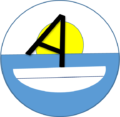Sometimes you get a little more wind than you are expecting. We checked and checked the wind yesterday, and also the wave height and periodicity, and decided that even though it was predicted to be around 13 m/s average winds, we have sailed several longer trips in those conditions and know how Lulu handles (very well). We used several apps to check and prepared the boat for hard weather sailing – everything was secured / stowed as best we knew. So we decided to sail south while we could since it was westerly wind, as the wind was going to change and blow from the south the next day, which would be a problem for sailing south. Unfortunately, the wind and waves were stronger than expected, and we saw up to 19 m/s or up to 37 knots, which is a Gale or Beaufort 8.
There are always lessons to be learned, and we realized that we can do more to prepare Lulu for hard weather sailing. You might think we are strange / stupid for setting out in even an average 13 m/s, but as noted we have sailed up to 17 m/s with Lulu and know how she handles. It is a question of what your crew can manage, what your boat can manage, and your ability to get yourself out of trouble if necessary. It was a clear day with great visibility, we were within a few miles of land for most of the trip and could run for shelter if necessary, we have good storm sail set-up, and it was really good training for us because we need to know what can be an issue, in case we have a situation further along where we have to sail in even tougher conditions. Since the wind was coming from the west, we expected a sidewind which is easier than wind close to the nose; and also we hoped to have some relief from the waves due to sailing close to land.
First we learned that you should turn around your dorade vents if you have them. These are the big air vent holes on deck. For normal conditions, if water washes over the deck, they are built to handle the water flow and the water runs off to the side, and until yesterday we have never had any water come down them. However, since Lulu has a low profile and her nose goes through the water often in high seas, a lot of water runs across her deck. Again, not a problem for us, the deck is designed to allow the water to run off and we didn’t have water running down as far as the cockpit. However, apparently, at one point the poor dorade vent on the port side filled over the capacity of the water lock, so water gushed into the salon.
Water in the salon is mildly irritating, but the boat worked like it was designed to and the water ran into the bilge. Unfortunately, the automatic bilge pump didn’t work, so today Magnus is working on the bilge. Not a problem, it wasn’t a lot of water for our bilge, the manual pump worked and we cleaned up everything after we got in and wiped everything down, you couldn’t tell last night that there had been water in the boat. But a reminder to periodically not only check that your bilge starts when tested, but that it also pumps water when it starts.
Other good lessons were to keep the top of the hatch from the cockpit into the salon closed. We had kept the hatch door section that faces the cockpit in place so that if there was any water in the cockpit, it wouldn’t flow over into the salon. But we forgot to pull the top part of the hatch over, as it is under the sprayhood. But water finds a way, fortunately we only got a little bit of water in that way.
Our anchor was tied down, we had noted that it bounced in it’s holder when the nose got covered by water so Magnus had tied it extra carefully. But somehow the anchor chain loosened, and the anchor slid through the ropes binding it to hang free in front of the boat. Despite turning the boat to avoid the worst of the swell, Magnus got drenched while re-securing the anchor. So we will work on securing the chain as well, not just the anchor, if we ever expect to travel in high seas.
Finally, we recommend always having food on hand that you don’t have to prepare at all – fruit, energy bars, anything – that you can just eat. If you need to focus on taking care of a bilge or anchor and it’s lunchtime, it can be helpful to have something little on hand. We had prepared a meal that just had to be heated and had instant soup on hand, but heating food or cooking water requires that someone go below deck and turn on and off the stove. One final recommendation, don’t toss food to your crew members, if they miss it can drop into the sea. 🙂

